Dual Xeon Scalable Overclocking: ASUS WS C621E 'Sage' Workstation Motherboard Announced
by Joe Shields on October 24, 2017 4:20 PM EST
ASUS has quietly announced a new motherboard: the WS C621E SAGE (or just 'Sage' for short). This workstation class board offers users dual Intel LGA-3647 sockets with CPUs up to 205W each, which should support the full lineup of Intel Xeon Scalable processors using Skylake-SP cores. This should mean dual processor support for Bronze CPUs through Platinum CPUs, allowing up to 56 cores (112 threads) in a single system, but also with numerous extras in PCIe and storage. The Sage also supports up to 12 DDR4 RDIMM or LR-DIMM ECC modules with a capacity of 768GB per socket, 1.5TB total, and speeds supported to DDR4-2666.
Aside from drooling over such a system, one of the stand-out features listed for the Sage is its ability to overclock both CPUs. We have been told by Intel that none of the Xeons are overclockable, which usually means that the CPU multiplier is not adjustable. ASUS hasn't released any details on the overclocking capabilities, however there are two ICS chips on the board which are usually attached to motherboards that offer significant base clock frequency adjustment, so our current thoughts are it will be using BCLK adjustments for overclocks. BIOS redundancy did not make it on the Sage as there is only a single BIOS chip on the board.

Two ICS chips and a single BIOS chip
There are seven total PCIe slots with three in x16 mode, two in single x16 or dual x8/x8, and two more at x8 mode (likely x16/x8/x16/x8/x16/x8/x16) from the processors. The dual socket system is able to use PCIe lanes from both CPUs, however only one can have a DMI to a chipset.
Partially hidden below the chipset heatsink is an interesting addition to a motherboard - an FPGA. This is a Lattice FPGA chip (LCMXO2-1200UHC-4FTG256C), which apparently offers enhanced I/O features such as drive strength control, slew rate control, PCI compatibility, bus-keeper latches, and pull-up resistor control. Built on the 65nm process, it has 1280 logic elements running at 269 MHz. Aside from doing what it says on the tin, we don't exactly know why ASUS is using this chip (over anything else perhaps), although given the lane count on the motherboard we suspect it might be acting as a small PCIe switch as well. We reached out to ASUS for a chipset diagram to confirm our thoughts, and are awaiting a response.
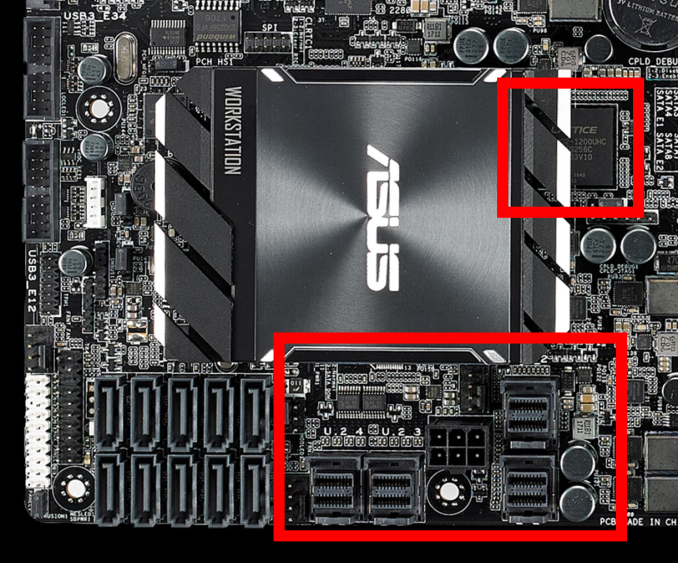
Lattice FPGA and U.2 ports with 6-pin PCIe
Remote management is handled by the ASPEED AST2500, which has a small amount of Micron memory attached. Normally we see this controller partnered with a D-Sub and an ethernet port, although ASUS lists this as 'optional'. There is no pin pad to place either of these, which perhaps suggests that admin access is obtained through the OS or over a managed network connection using on of the network ports.
For storage purposes, the board has four U.2 ports capable of RAID 0 and a single M.2 slot able to fit up to a 110mm module and supports both PCIe and SATA modes. All U.2 and M.2 ports are PCIe 3.0 x4. This would mean 20 lanes for storage, and given the PCIe lane breakdown of the PCIe slots and storage, we suspect at least two of the U.2 ports might be fed from the chipset (which the chipset diagram would confirm).
The Sage comes with 10 SATA ports, oriented vertically and located below the U.2 ports on the bottom right-hand side of the board. This configuration can potentially be a pain that if you need to remove a locking cable from the bottom, it can require removing all of the cables above it due to the close proximity of the next port(s). Eight of these ports are connected via the chipset and support RAID 0, 1, 5, and 10, while the other two are connected via ASMedia SATA controller.
The WS C261E Sage also has a microSD card reader just below the middle DRAM slots and is typically used for base lightweight operating systems. This is likely connected over an eMMC interface to the chipset.
USB support is handled by an ASMedia chipset for the USB 3.1 (10 Gbps) ports and the C621 chipset for the remainder. The back panel has Type-A and Type-C USB 3.1 10 Gbps ports, along with four USB 3.0 ports and two USB 2.0 ports. Network capabilities are handled by two Intel I210-AT Gigabit LAN controllers. For audio duties, the Sage comes with an ASUS collaborated Realtek S1220A codec and what looks to be Nichicon premium audio caps. The back panel IO for the audio is a 5 plug stack plus a SPDIF plug.
Power delivery for each socket looks to be 7-phase and managed by International Rectifier 3541 Digital Multi-phase buck controllers.
The C621 chipset adds some features over the C610 (Wellsburg) chipset of the previous generation, adding Node Manager 4.0 for power and cooling optimization as well as compute resources in an enterprise environment. Native USB 2.0 ports remain unchanged with 14, however, the C620 chipset offers up to 10 USB 3.0 ports. Chipset and CPU communication in the DMI also gets a bump from PCIe 2.0 x4 to PCIe 3.0 x4 doubling bandwidth. NVMe is now natively supported. In the past, platform integrated firmware limits the way builders can customize or differentiate their offerings. On the C620 chipset, the Innovation Engine is enabling system builders to run firmware of their own or choosing for specific use scenarios (server, storage, etc).
Pricing or availability has been announced at the time of writing. If prices of previous 2P motherboards are anything to go by, we suspect this motherboard to retail (if it hits retail) north of $700. The processors going into the board could be from a few hundred each to the top-of-the-line Platinum 8180 ($10009), but not the 8180M versions ($13011) as the motherboard does not support 3DS LR-DIMMs. Either way, the board might end up being a small amount of an overall system build.
| ASUS WS C621E Sage | |
| Warranty Period | 3 Years |
| Product Page | Link |
| Price | N/A |
| Size | EEB (12" x 13") |
| CPU Interface | LGA 3647 |
| Chipset | Intel C621 |
| Memory Slots (DDR4) | Twelve DDR4 Supporting 768GB (each socket, 1.5 TB Total) Hex Channel Up to 2666 MHz RDIMM, LR-DIMM |
| Network Connectivity | 2 x Intel I210-AT Gigabit LAN |
| Onboard Audio | Realtek S1220A |
| PCIe Slots from CPU | 3 x PCIe 3.0 x16 (x16 mode) 2 x PCIe 3.0 x16 (Single at x16, dual at x8/x8) 2 x PCIe 3.0 x16 (x8 mode) |
| PCIe Slots from PCH | None |
| Onboard SATA | 8 x SATA from Chipset (Supports RAID 0/1/5/10) 2 x SATA from ASMedia |
| Onboard SATA Express | None |
| Onboard M.2 | 1 x PCIe 3.0 x4 or SATA |
| Onboard U.2 | 4 x PCIe 3.0 x4 or SATA |
| USB 3.1 | ASMedia: 1 x Back Panel Type-A 1 x Back Panel Type-C |
| USB 3.0 | 4 x Back Panel 2 x Headers |
| USB 2.0 | 4 x Back Panel 2 x Headers |
| Power Connectors | 1 x 24-pin ATX 2 x 8-pin CPU 1 x 6-pin PCIe |
| Fan Headers | 2 x CPU (4-pin) 7 x Chassis (4-pin) |
| IO Panel | 1 x PS/2 Mouse/Keyboard Port 2 x RJ-45 LAN Ports 1 x BIOS Flashback Switch 2 x USB 3.1 (10 Gbps) 4 x USB 3.1 (5 Gbps) 4 x USB 2.0 1 x Optical SPDIF 1 x USB BIOS FLashback Button 1 x 5 plug audio stack |
| Other Features | ProCool Power Connector USB BIOS FLashback ASUS PIKE SAS upgrade kit |
(Ian: It would be amazing if this spawned a few motherboards with Final Fantasy-esque jobs as their names.)
Related Reading:
- Sizing Up Servers: Intel's Skylake-SP Xeon versus AMD's EPYC 7000
- AMD's Future in Servers: New 7000-Series CPUs Launched and EPYC Analysis
- Intel Launches Xeon-W CPUs for Workstations: Skylake-SP & ECC for LGA2066
- GIGABYTE Server Announces MW51-HP0 Motherboard: C422 for Intel Xeon-W
Source: ASUS



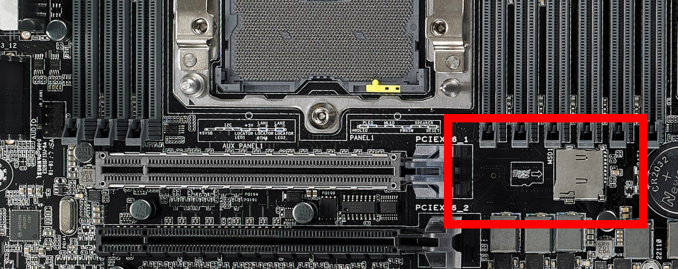
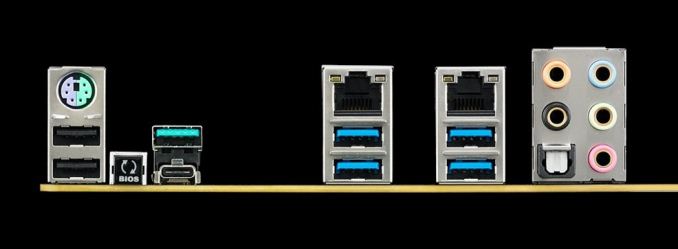
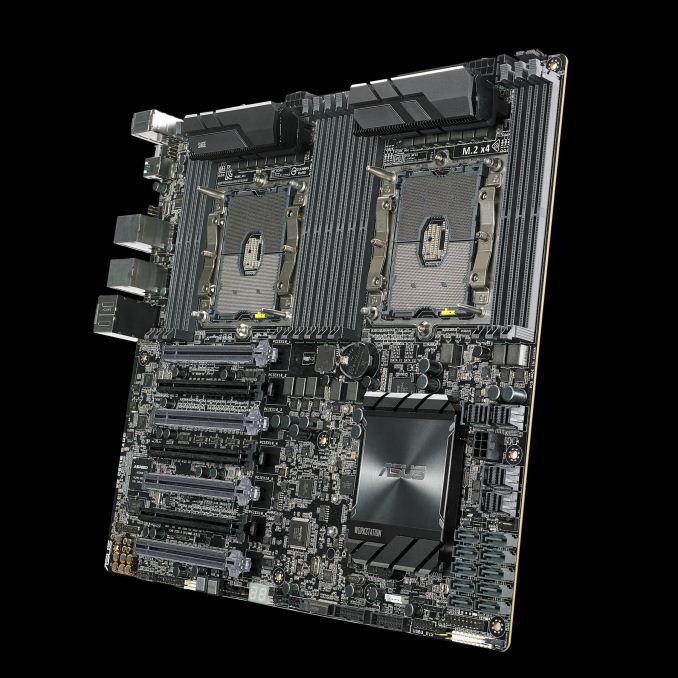
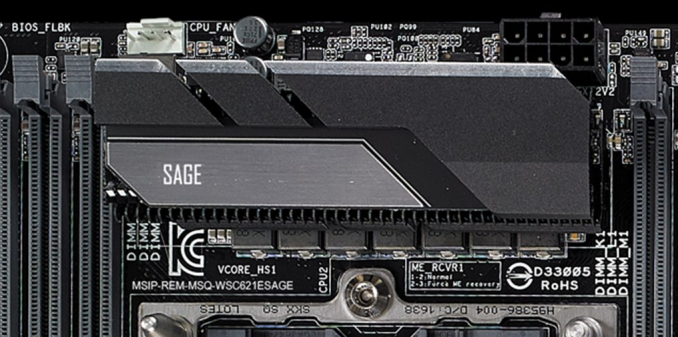













48 Comments
View All Comments
mode_13h - Tuesday, October 24, 2017 - link
BTW, the lanes used by the PCIe slots add up only to 80. That should still leave 16 CPU lanes for peripherals.CheapSushi - Tuesday, October 24, 2017 - link
How is that dumb? We finally get more options on these types of boards and you don't want it there? THEN DON'T USE IT. It's time for artificial segmentation and limitations DIE. Let Enthusiasts do what they want.ddriver - Wednesday, October 25, 2017 - link
"THEN DON'T USE IT"Thanks for that invaluable advice. I was just about to order, you are a true life saver ;)
CheapSushi - Wednesday, October 25, 2017 - link
Sometimes the obvious goes over your head and you resort to cynicism instead. That's cool.ddriver - Wednesday, October 25, 2017 - link
Talking about the obvious, nope, I do not "resort" to cynicism, you mistake sarcasm for cynicism, which are very different things.Sarcasm is the usage of irony to express contempt. Which is exactly what I did.
Cynicism, in its contemporary meaning is the general distrust in the motives of others for being intrinsically selfish. Or in its classical meaning, cynicism is the state of living in harmony with nature. Neither of the two are featured in the post that triggered your keen "cynicism" senses ;)
Now you've learned something new ;)
Besides, I was merely expressing an educated opinion. It is you who had a problem with that, and threw a bunch of irrelevant and ignorant nonsense at it. Thus you have earned that bit of sarcasm at 100%. You shouldn't complain to others for things that you do yourself ;)
And then you are asking "How is that dumb?" when my statement was immediately followed by how and why that is the case, which is dumb too. Unlike you, I always argument my statements, saying something is dumb is simply not constructive, which is why when I say that something is dumb, it is always accompanied by the reasons why.
There is a big difference between making a nonsense product and overcoming segmentation. The former is dumb, the latter is good. This product does not overcome segmentation. It is just a dumb nonsense product, accompanied by respectively as dumb marketing. If you look at "server" glade boards, this board doesn't really offer anything segmentation-overcoming, it just comes with pointless nonsense features, the only other fundamental difference to a server board is the color, which again... is quite dumb, if that is a determining factor when making a 20k+++ workstation purchase decision. Dumb dumb dumb, dumb-didi-dumb dumb.
CrazyHawk - Friday, October 27, 2017 - link
Wow...extide - Wednesday, October 25, 2017 - link
Overclocking Xeons was a pretty big thing back when it was allowed. Last time was the LGA1366 era and that EVGA SR-2 board was pretty popular. Sure, your typical Server and Workstation users aren't looking to overclock, but that doesn't mean nobody is looking to do it. The pricing is a lot different now, though. It was pretty spendy to get into a dual 6 core SR-2 system back then but now the Xeons are way more expensive.Vatharian - Tuesday, October 24, 2017 - link
No wonder, there is single BIOS chip. Base Purley platform has 256 Mbit chip, and it takes good 5 minutes to flash. With ASUS stuff, I wouldn't be surprised if 512 Mbit chips was used.Board is fine, but the lack of 10G is painful.
And no, the Lattice is NOT acting as a PCIe switch. It's there mostly for I/O VR and phase control. There is even separate chip, that handles the FPGA programming, on each poweron (not boot), trough JTAG. Purley development also have those.
Fun fact: These board may not support PCIe bifurcation due to firmware limitation at launch.
mode_13h - Tuesday, October 24, 2017 - link
PCIe bifurcation for *what*? With 2 CPUs, it already has more lanes than slots.CheapSushi - Tuesday, October 24, 2017 - link
@mode_13h for things like NVMe adapters with 4x M.2 drives; example HighPoint SSD7110 and ASUS HYPER M.2 X16. A pure, full x16 NVMe drive does not exist, and if any due, they're still multiple drives daughterboarded. Only very few are even true x8 also; controller issues mainly. It also ends up MUCH cheaper often to go adapter route than single AIC/HHHL. And yes, multiple NVMe drives for an enthusiast and workstation board is nothing to scoff at.